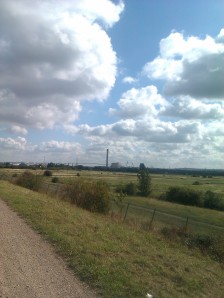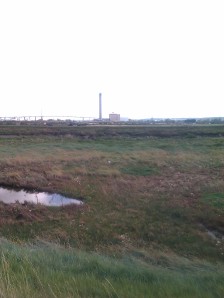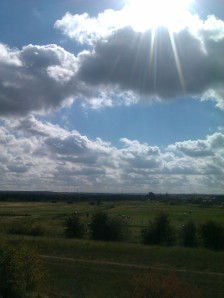September, and perfect walking weather. Bright sunshine continues and a pleasant temperature. Walking along the estuary is almost like being at the seaside, and, indeed, Erith had a brief flirtation with the idea of being a resort in the nineteenth century before the industry moved in. It has a pier.
For me it is the birthplace of that much lamented comedian: Linda Smith.
This is the first section in David Sharp’s guidebook to the London Loop and is indeed a magnificent beginning.
The walk along the Thames is quite short .(I note with interest that the Thames Path is now extended to these parts.) Then it is necessary to weave your way along roads and industrial sites for a little while before coming to a splendid path which crosses Crayford Marshes.
The raised causeway takes you past Erith Saltings , where a submerged fossilised forest is visible at low tide. In the distance the Dartford power station can be seen and the Queen Elizabeth the Second Bridge, which takes traffic along the M25.
I’m a big fan of raised causeways, especially when it’s not lightening. There are ditches between you and any grazing wildlife below. Here there were many ponies.
At Crayford Ness the Loop turns inland to follow the River Darent. At its mouth is a flood barrier.
The area is rich in bird life and I passed keen ornithologists with telescopes. Soon afterwards the river divides and the Loop follows the River Cray. 
Eventually the path comes to an end and wending your way through an industrial estate and crossing the A206 you continue along the Cray more or less all the way to Bexley. Unfortunately, i had neglected to charge my phone and was unable to take any further pictures.
The Cray changes in character and is bordered by willows. The Loop goes through Crayford, where the Roman Watling Street forded the Cray. Then it goes through parkland and passes a historic house Hall Place, where I consumed a cream tea beside the river in the afternoon sunshine.
After this I found my way under a main road and a railway, through a wood to Bexley church with its distinctive spire that starts as a pyramid and has an octagonal shaped part on top. Bexley has a number of historic houses. I returned from here by train, having added nine miles to the total.




